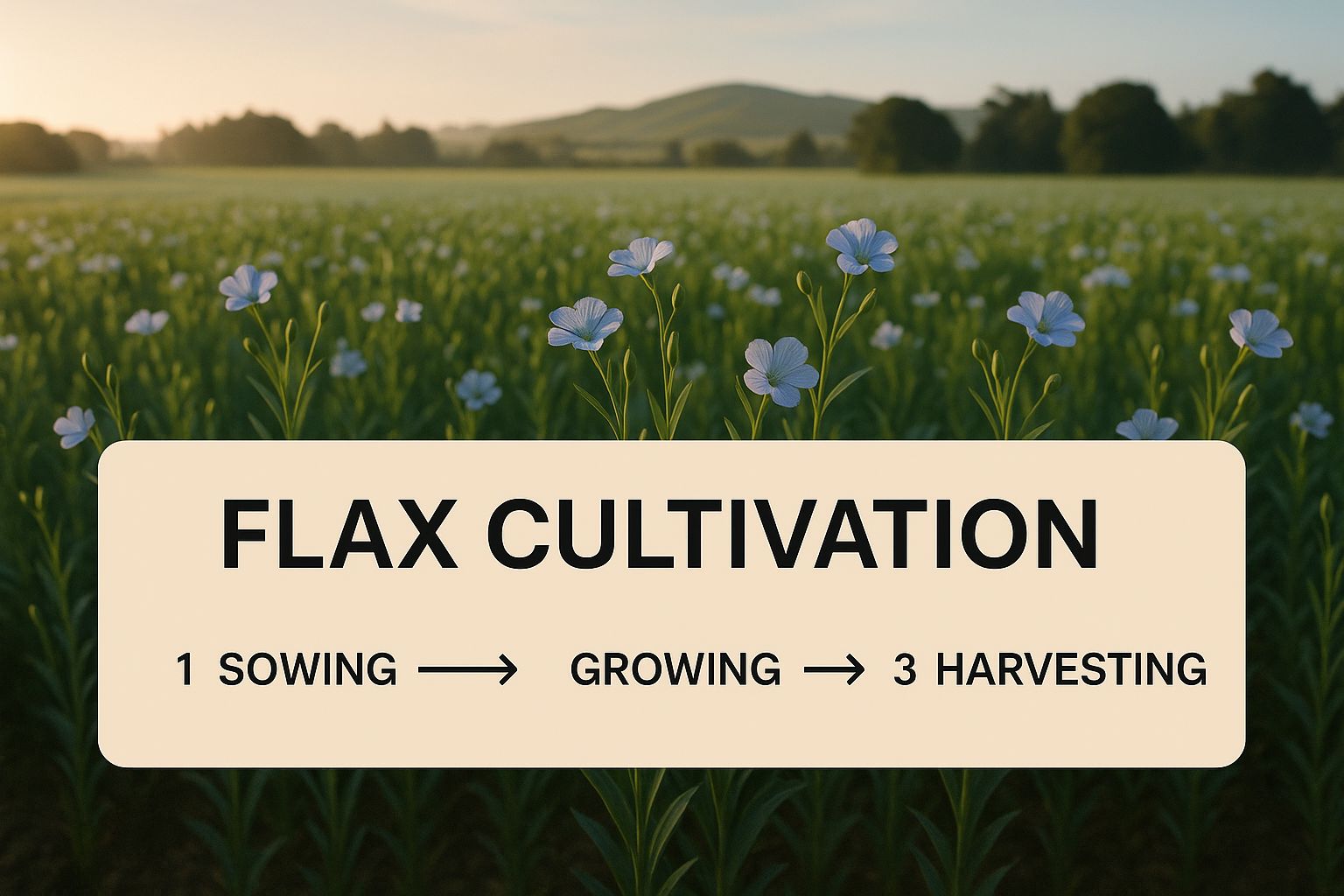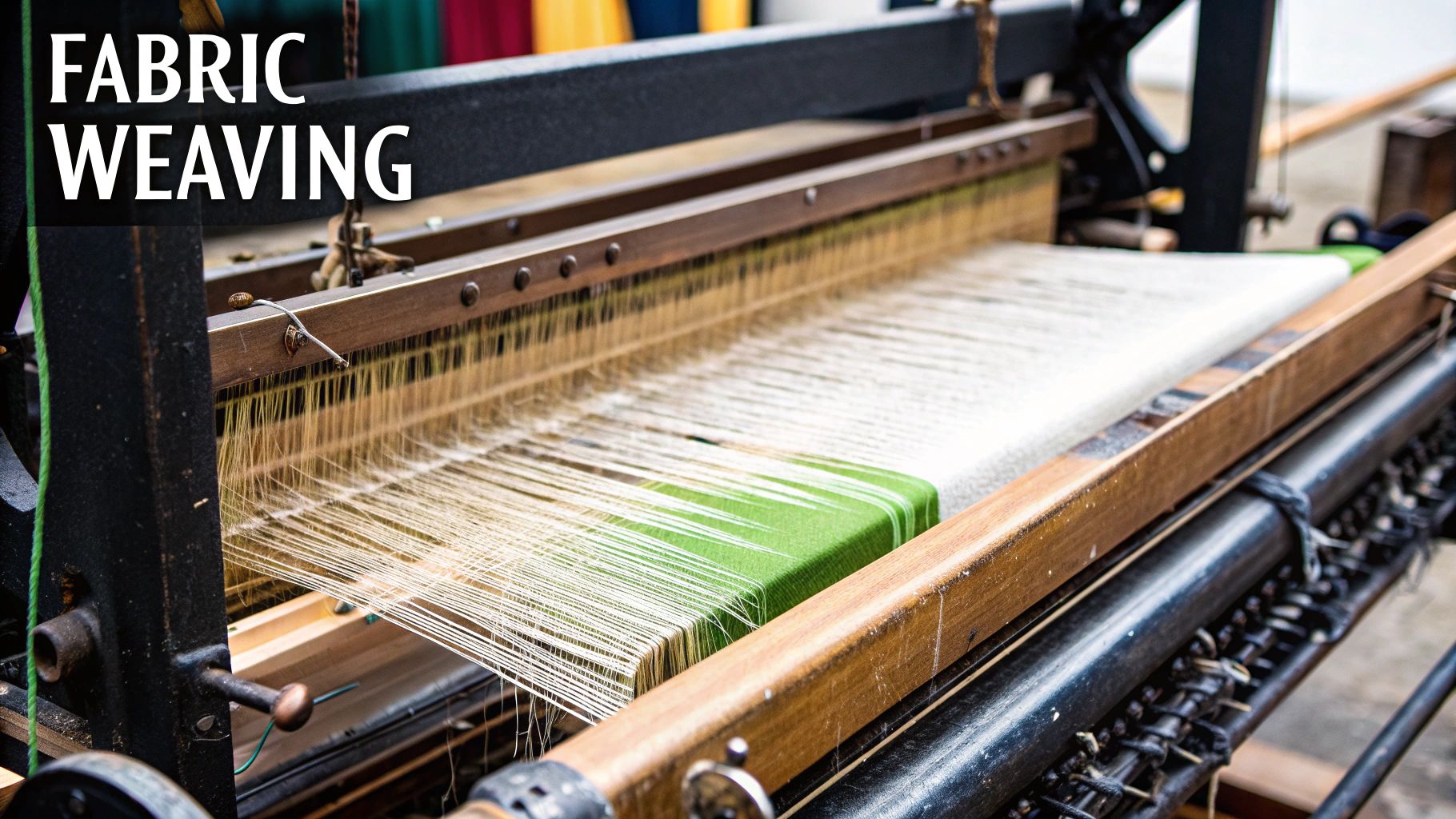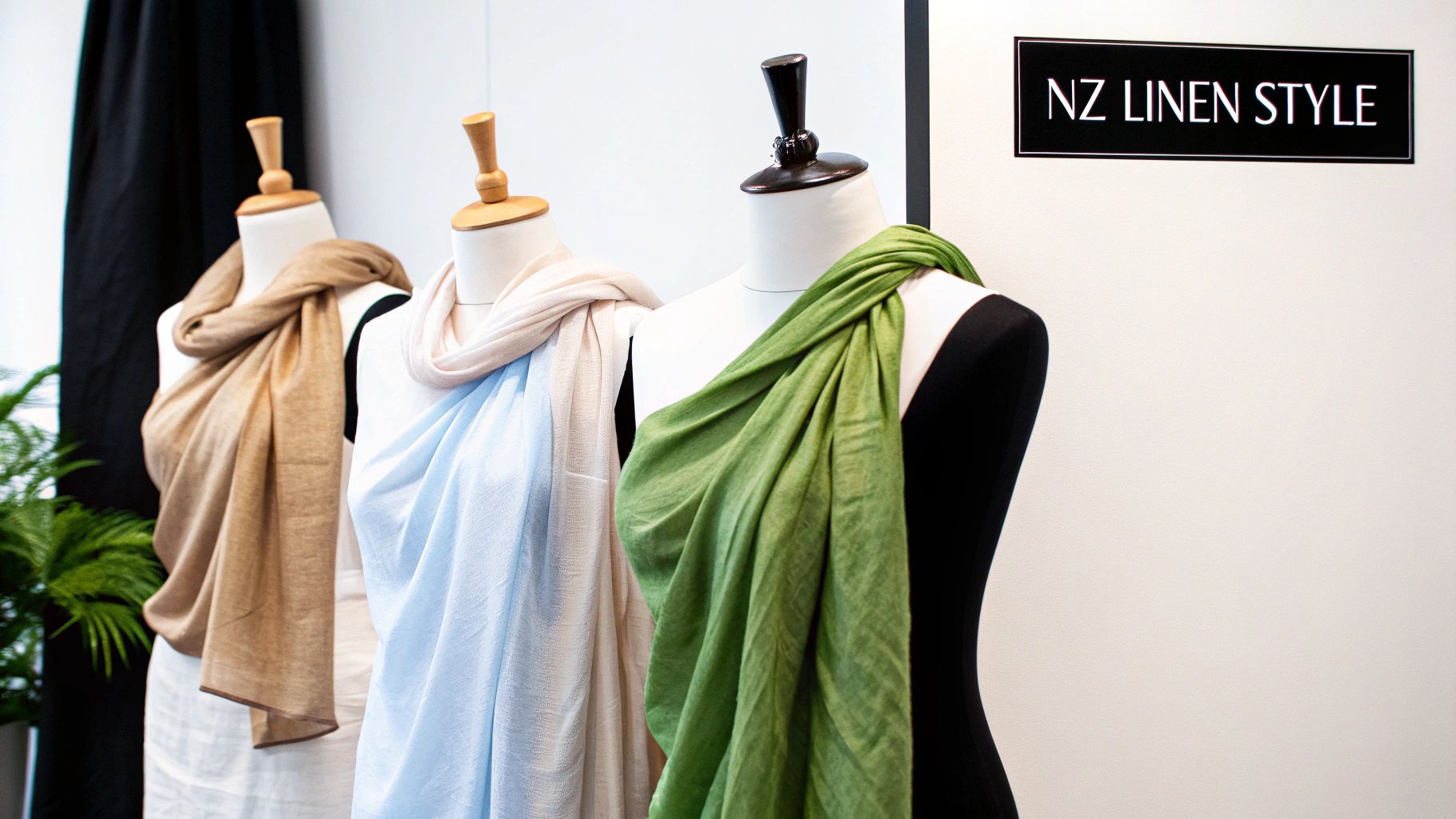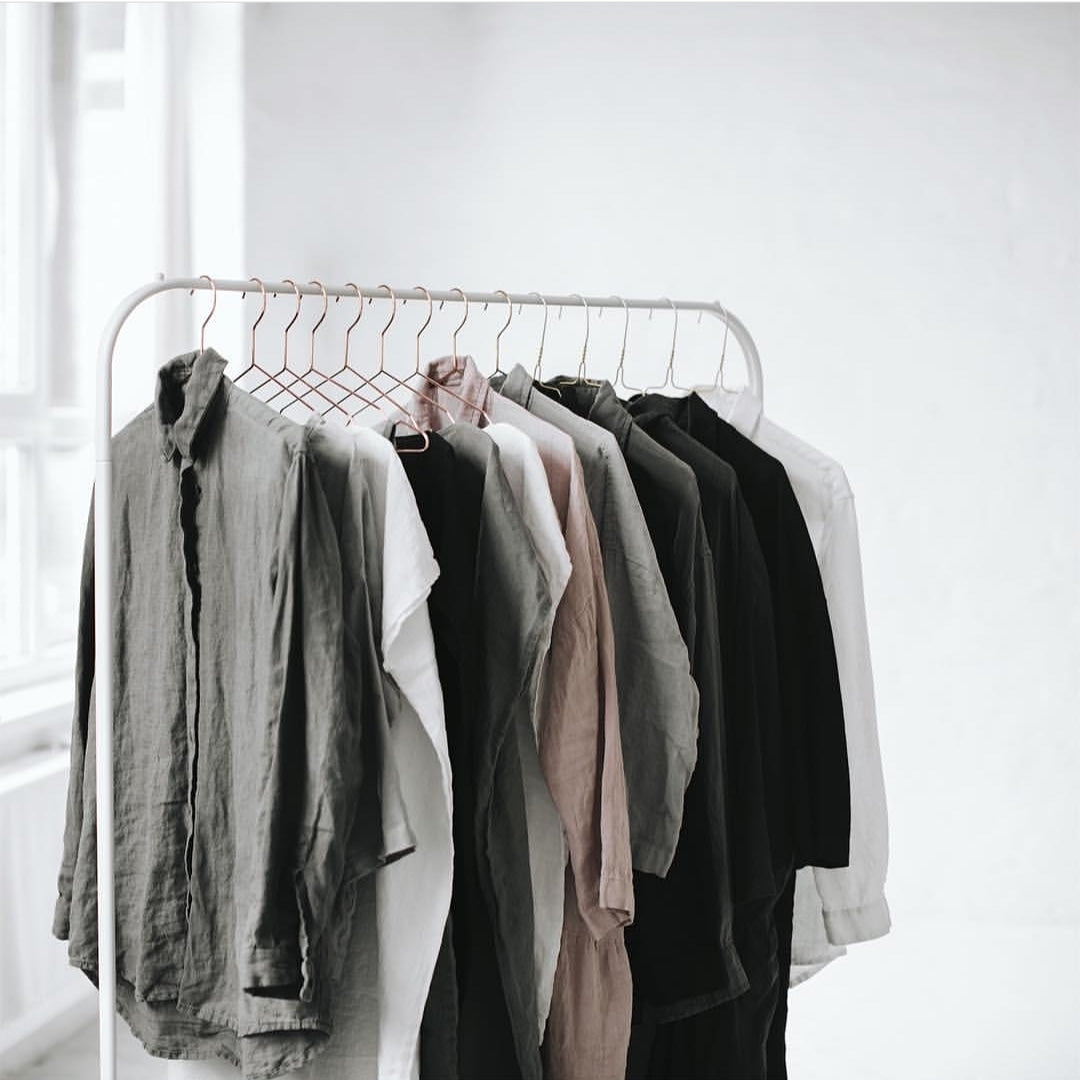Linen has long been a favourite material here in New Zealand, and for good reason. We love it for its classic, relaxed style that just seems to fit our way of life. It’s more than just a fabric; it's about connecting with nature and choosing quality that lasts, which is why you’ll find it everywhere from our bedrooms to our wardrobes.
Why Linen Is So Loved in New Zealand
In Aotearoa, linen isn't just another textile—it embodies some of our core values. Its popularity comes down to a perfect mix of practicality and principle, hitting the mark for Kiwis who want things that are not only beautiful but also made to stand the test of time.
The fabric's earthy, understated look fits right in with our design aesthetic, which often favours calm, nature-inspired spaces and easy-going fashion. This connection to the land and a simpler lifestyle makes linen an ideal choice for the New Zealand climate.
Here’s why it’s a firm favourite:
- Perfect for Our Climate: Linen is incredibly breathable and moisture-wicking. It keeps you cool and comfortable during those sticky summer months but also works as a surprisingly cosy layer when the temperature drops.
- Built to Last: As one of the strongest natural fibres out there, linen is a smart investment. It stands up to the rigours of family life and daily wear, and the best part is, it just gets softer and more beautiful with every wash.
- A Sustainable Choice: The flax plant, which gives us linen, is much kinder to the planet than cotton. It needs far less water and fewer pesticides to grow, a big plus for Kiwis who care about their environmental footprint.
It's worth noting that the European flax used for high-quality linen is completely different from our native harakeke. While we often call both "flax," they are distinct plants. Harakeke holds immense cultural significance for Māori weaving and was a major colonial industry, but the story of European flax cultivation in New Zealand is its own smaller, fascinating chapter.
Trials to grow linen flax actually started at Lincoln back in 1936. This was driven by a need for a secure supply as things got tense globally before the Second World War. At its peak, around 300 acres were being cultivated across the country. If you’re curious, you can learn more about the early days of NZ linen flax cultivation and its place in our history.
This unique local history, combined with its modern appeal, really cements linen’s place as a cherished material here in New Zealand.
The Journey from a Humble Flax Plant to Your Favourite Linen
Every beautiful piece of linen starts its life in the most unassuming way: as a flax plant growing in a field. To truly appreciate why we value New Zealand linen material so much for its quality and strength, you have to understand its incredible journey from seed to fabric. It's a story steeped in patience, natural processes, and generations of craftsmanship.
This isn't some high-tech, automated process. Far from it. It's an age-old tradition that feels more like nurturing a garden than running a factory. The entire journey is labour-intensive, demanding a real connection and understanding of the plant at every single step.
The infographic below shows the very first, and arguably most important, part of the process – growing the flax.

It’s a great reminder that the luxurious fabric we end up with has its roots firmly planted in the earth. The quality starts right here, in the field.
From Harvest to Fibre
Once the flax plants reach maturity, they’re harvested—often pulled right up from the roots to keep the fibres as long as possible. This is where the magic really begins. The stalks are laid out in the field for a process called retting. Here, the morning dew and natural bacteria work together to gently break down the tough, woody outer part of the stalk, freeing up the soft linen fibres inside.
After the retting is complete, the stalks are dried. Next comes scutching, a mechanical process that separates the raw fibres from the unwanted woody bits. Think of it like threshing wheat to get to the grain. What’s left behind are the long, silky strands of raw flax, ready for the next stage.
The secret to linen's incredible strength lies in its long fibres. Unlike cotton, which has short fibres, flax fibres can run the entire length of the stalk. This creates a yarn that is exceptionally strong and far less likely to break.
Spinning and Weaving the Final Fabric
Now it's time to refine those raw fibres. They go through a combing process called hackling, which aligns all the fibres and gets rid of any short or knotty bits. This step is crucial because it ensures only the longest, strongest fibres make it into the final yarn, which is the hallmark of high-quality linen.
These pristine fibres are then carefully spun into yarn. It takes a skilled hand to create a thread that's both consistent and strong.
This traditional, hands-on approach is what gives linen its distinctive character—that legendary durability, its incredible absorbency, and the beautiful, slightly slubby texture that only gets softer and better with every wash. For a closer look at these fascinating steps, check out this guide on how linen is made.
Finally, these spun threads are woven into the gorgeous fabric we all know and love, ready to be made into cherished items for our homes and wardrobes here in New Zealand.
The Two "Flaxes" of New Zealand: A Story of Confusion and Heritage
When you start digging into the story of linen material in NZ, you quickly stumble upon a fascinating, and frankly, a bit confusing, piece of local history. It turns out, New Zealand has two completely different plants that have been called 'flax'. It’s a classic case of mistaken identity that’s essential to understand.
First, you have the European flax, Linum usitatissimum. This is the plant that gives us the soft, beautiful linen fabric we all know and love. It's the source of the linen used in homewares and clothing today.
But then there's our native harakeke, Phormium tenax. Early European settlers also called it "flax" because of its long, strong fibres, but it's a totally different species. Harakeke is deeply woven into Māori culture, used for centuries to create everything from practical kete (baskets) and clothing to constructing the walls of pā (fortifications). This was New Zealand's original textile industry, long before linen arrived.
The Booming Harakeke Trade
When colonists arrived, they saw commercial potential in harakeke. Recognising the incredible strength of its fibres, they set up a massive milling industry to turn its leaves into rope, twine, and woolpacks for the burgeoning agricultural sector.
This wasn't some small cottage industry; it became a major export earner for the young country. At its absolute peak in 1907, New Zealand had around 240 mills pumping out over 36,140 tonnes of fibre. This industry literally shaped entire regions, especially places like the Manawatū. It's a really unique part of our industrial past, which you can read more about in this technological history of NZ flax milling.
European Flax: A Brief, Wartime Endeavour
The story of true linen flax in New Zealand is a much smaller, more focused tale. Its cultivation really only took off during World War II when traditional European supplies were completely cut off. While it was a vital effort for the time, it never came close to the sheer scale of the harakeke trade and quietly faded out after the war.
It’s crucial to get this straight: the tough, industrial fibre from our native harakeke and the delicate, refined fibre from European linen flax are worlds apart. Each has its own unique story and place in New Zealand's history.
So, while the linen products you buy in New Zealand today are made from European flax, the powerful legacy of harakeke—our "other" flax—adds a rich, local chapter to the global story of this incredible fibre. It’s a defining part of who we are.
How to Choose the Right Linen for Your Home and Wardrobe

Walking into a store or browsing online, you'll often see terms like 'Belgian' or 'French' linen thrown around, which can make choosing the right fabric feel a bit complicated. But here’s a little industry secret: those labels usually just tell you where the flax plant was grown, not necessarily where the final fabric was woven. European flax, especially from France and Belgium, is highly sought after because the climate there is perfect for growing long, strong fibres.
When you're searching for beautiful linen material NZ retailers have in stock, the best thing you can do is think about what you’ll be using it for. The two most important things to consider are the weight and the weave—these will determine how the fabric feels, how it hangs, and how well it holds up over time.
For instance, a lightweight, almost gauzy linen is exactly what you want for summer clothing. Think of a floaty dress for a beach wedding or a casual shirt that keeps you cool on a humid Auckland day. On the flip side, a heavier, more densely woven linen is the workhorse you need for things that get a lot of use, like sofa upholstery or bedding that you want to last a lifetime.
Understanding Linen Weaves and Weights
The "hand" of a fabric—a term we use to describe how it feels to the touch—along with its weight, are your best guides. Linen weight is measured in GSM, which stands for grams per square metre. It's quite simple: a lower GSM means a lighter, more delicate fabric, while a higher GSM points to a denser, more substantial weave.
Here’s a quick guide to help you pick the right one:
-
Lightweight Linen (Under 150 GSM): This is the dream for summer clothes. It’s incredibly breathable and has a lovely, soft drape that’s perfect for shirts, scarves, and breezy dresses. It’s light enough to catch the wind, making it ideal for the classic Kiwi summer.
-
Medium-Weight Linen (150-220 GSM): This is the all-rounder. Versatile and practical, this weight is fantastic for everything from tablecloths and cushion covers to trousers and more structured garments. It strikes that perfect balance between durability and softness.
-
Heavyweight Linen (Over 220 GSM): When you need something that can take a beating, this is your linen. Its dense weave makes it tough enough for upholstery, hard-wearing tote bags, and cosy winter-weight bedding. This stuff is built to last and only gets better with age.
The real magic of linen is that it improves over the years. No matter its initial weight, every wash softens the fibres, making it more comfortable and textured without losing any of its famous strength.
Comparing Linen Types for Your Needs
To make the decision even clearer, it helps to see how different types of linen compare. It’s not just about where the flax was grown; blends with other fibres, like cotton, can dramatically change how the fabric behaves.
A linen-cotton blend, for example, gives you a bit of the best of both worlds—the softness of cotton and the strength of linen. It also tends to wrinkle less and is often a bit friendlier on the wallet, making it a great way to dip your toes into the world of linen.
To help you choose with confidence, here’s a quick comparison of the most common options you’ll find in New Zealand.
Choosing the Right Linen for Your Needs
This table breaks down the most common linen types and blends, outlining their unique qualities and where they shine in our homes and wardrobes.
| Linen Type / Blend | Key Characteristics | Best For in NZ | Feel & Drape |
|---|---|---|---|
| 100% European Linen | Exceptionally strong, highly absorbent, and becomes softer with each wash. The gold standard for quality. | Bedding, high-quality apparel, and heirloom homewares. | Crisp initially, softens beautifully. Drapes elegantly. |
| Linen-Cotton Blend | Softer from the start, less prone to heavy wrinkling, more affordable. | Everyday clothing, casual tablecloths, and children's bedding. | Soft and comfortable with a relaxed, gentle drape. |
| Stonewashed Linen | Pre-washed with stones (like pumice) to accelerate the softening process. | Ready-to-use bedding, relaxed-fit clothing, and soft furnishings. | Incredibly soft and supple with a lived-in, casual look. |
| Heavyweight Upholstery Linen | Very dense and durable weave, designed to withstand significant wear and tear. | Sofas, armchairs, headboards, and heavy-duty cushions. | Sturdy and textured, with a structured feel and minimal drape. |
Ultimately, whether you're investing in a forever-piece for your home or a new favourite shirt, understanding these small differences will help you find a linen you'll love for years to come.
The Practical and Sustainable Benefits of Using Linen
When you're choosing a fabric, it’s about so much more than just looks. It’s about how it feels, how it holds up to daily life, and the footprint it leaves on our planet. For a growing number of Kiwis, linen isn't just a purchase; it's a conscious choice for quality, comfort, and sustainability. It’s a textile that’s as practical as it is beautiful, making it a perfect fit for the New Zealand way of life.

One of the first things you’ll notice about linen is its incredible breathability. The flax fibres are hollow, which allows air to move freely through the fabric, making it feel wonderfully cool and crisp against your skin. Whether you’re enduring a humid Northland summer or a scorching Canterbury afternoon, linen clothing and bedding act like your own personal air conditioning, wicking moisture away to keep you feeling fresh and dry.
But it’s not just a summer fabric. Those same thermoregulating qualities mean linen provides a touch of insulation when things get chilly. It’s this smart versatility that makes linen material NZ wide such a brilliant choice for our famously four-seasons-in-one-day climate.
A Healthy Choice for Your Home and Family
Beyond pure comfort, linen brings some serious health and wellness perks to the table. It’s an ideal fabric for any home, particularly if you're dealing with allergies or sensitive skin.
- Naturally Hypoallergenic: The long, smooth fibres of linen are a tough place for dust mites and bacteria to thrive, which helps create a cleaner, healthier space to sleep and live.
- Antibacterial Properties: Linen has its own built-in antibacterial qualities, meaning it naturally stays fresher for longer than other fabrics. This is a game-changer for things like tea towels and bedding.
- Gentle on Skin: Often produced without the harsh chemicals used on other textiles, linen is incredibly gentle, making it perfect for babies, young children, and anyone with delicate skin.
This powerful combination makes linen not just a comfortable option, but a genuinely hygienic one for the whole family.
An Investment in Durability and Sustainability
In a time when we’re all thinking a bit more about our consumption, linen shines as a truly sustainable choice. The flax plant it comes from is a hardy crop, happy to grow in poor soil and needing far less water than cotton. In many cases, flax cultivation requires no irrigation at all, relying only on rainwater.
What's more, the entire plant can be utilised, leaving almost no waste behind. This impressively light touch on the environment is a huge part of why so many eco-conscious Kiwis are embracing linen. You can explore how choices like this add up by reading our thoughts on what sustainability truly is.
Linen is famous for its strength. In fact, it's one of the strongest natural fibres on the planet—about 30% stronger than cotton. This means linen goods aren't just beautiful; they’re built to be part of your family's story for generations.
This remarkable durability means that while linen might feel like an investment upfront, its sheer longevity makes it incredible value over time. You won't be replacing worn-out sheets or shirts every few years. Instead, your linen will just get softer and more comfortable with every wash, perfectly embodying the idea of buying well, once. It’s a practical, healthy, and responsible choice for modern living in New Zealand.
How to Care for Your Linen So It Lasts a Lifetime
Looking after your linen is actually pretty straightforward. It's less about following a rigid set of rules and more about understanding the fabric's unique personality. Forget high-maintenance materials; linen is tough, gets better with every wash, and is meant to be lived in. The first step? Learn to love its naturally relaxed, slightly rumpled look – that’s where its real charm lies.
The key to making it last is to be gentle. When washing, a cool and calm approach works best. Stick to a mild detergent and a gentle cycle on your machine, using either lukewarm or cold water. This simple step protects the natural fibres from any unnecessary stress.
For something you use all the time, like your bedding, getting the routine right makes all the difference. We've put together a specific guide on how to wash linen sheets to make sure they just get better and better over the years.
The Best Way to Dry Your Linen
Honestly, nothing beats the New Zealand sun for drying linen. Line-drying is the gold standard because it’s incredibly gentle on the fabric, leaving it with that fresh, crisp feeling a machine just can’t copy. It’s a beautifully simple method that feels connected to our heritage of working with natural fibres.
It’s interesting to think that New Zealand once had a huge flax milling industry, all centred around our native harakeke. After the first mechanised flax stripper was patented back in 1860, the industry boomed, hitting its peak in 1916 when we exported around 32,000 tons of fibre. The last of those mills closed down in 1985, but that history shows just how deep our appreciation for natural textiles runs.
If you’re short on time and need to use a dryer, just pop it on a low heat setting. The trick is to pull your linen out while it’s still a little damp. This stops it from getting that stiff, over-dried feeling.
Wrinkles aren't a flaw in linen—they're a feature. To keep them soft and relaxed rather than creased, just give your items a good shake after they come out of the wash and before you hang them up. If you do want a smoother finish, a quick once-over with a warm iron while the fabric is still damp does the trick beautifully.
At the end of the day, looking after your linen material nz is simple. A little bit of gentle care ensures every piece will become a softer, more well-loved part of your home for a very long time.
Your Linen Questions, Answered
When you're thinking about bringing linen into your home here in Aotearoa, a few questions always seem to pop up. It's a premium fabric, after all, and you want to know you're making a smart choice. We get it.
So, let's tackle some of the most common queries we hear about linen material NZ-wide. This should help clear up any lingering doubts and show you why it’s such a perfect fit for the Kiwi way of life.
Is Linen a Good Choice for New Zealand Weather?
It’s not just good; it's practically made for it. Linen's natural ability to regulate temperature makes it a brilliant choice for our famously unpredictable climate.
On those sticky, humid summer days, linen is a lifesaver. It breathes beautifully and wicks moisture away from your skin, keeping you cool and dry. But when a cool southerly whips through or the morning has a chill, it acts as a light, comfortable insulator. It truly adapts to our classic 'four seasons in one day' experience.
Why Is Linen More Expensive Than Cotton?
The price difference really comes down to the journey the fibre takes from the field to the fabric. Growing and harvesting flax, then turning it into linen thread, is a much more involved and lengthy process than producing cotton. It takes more time, more skill, and more manual effort.
It helps to think of it less as an expense and more as a long-term investment. Linen is incredibly durable—far more so than cotton. Your linen sheets, shirts, or tea towels won't just last; they'll get better with age, outliving their cotton counterparts by years and delivering real value over time.
Where Can I Find Quality Linen in NZ?
You can find beautiful, high-quality linen right across New Zealand, from brick-and-mortar stores to online boutiques. The key is to look for retailers who are open about where their fabric comes from. European flax, for example, is widely considered the gold standard.
- Boutique Homeware Stores: Many lovely independent shops in places like Auckland, Wellington, and Christchurch have a real focus on high-end textiles.
- Online Retailers: There are some fantastic New Zealand-based online stores that have curated stunning collections of linen bedding, clothing, and fabric.
- Specialist Fabric Shops: If you're a sewer, heading to a dedicated fabric store is your best bet for buying top-notch linen by the metre.
When you buy from brands that care about craftsmanship and quality, you know you're getting a piece that’s been made to be enjoyed for years to come.
At The Foxes Den, we’re all about bringing the timeless, understated luxury of quality linen into New Zealand homes. We invite you to explore our own curated collection of beautiful linen bedding and homewares, all designed to make everyday living feel a little more special. Discover the perfect linen pieces for your sanctuary at The Foxes Den.


